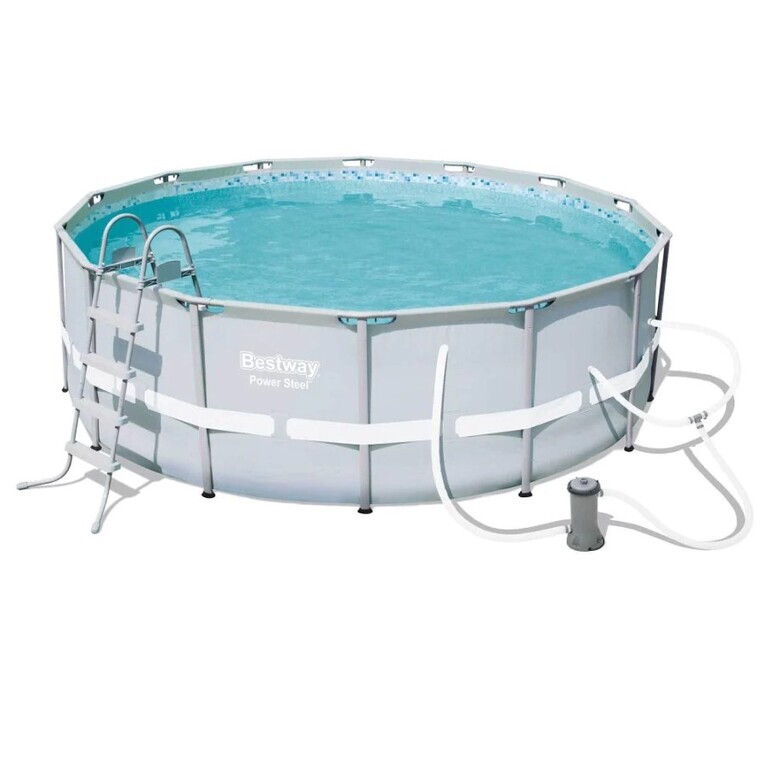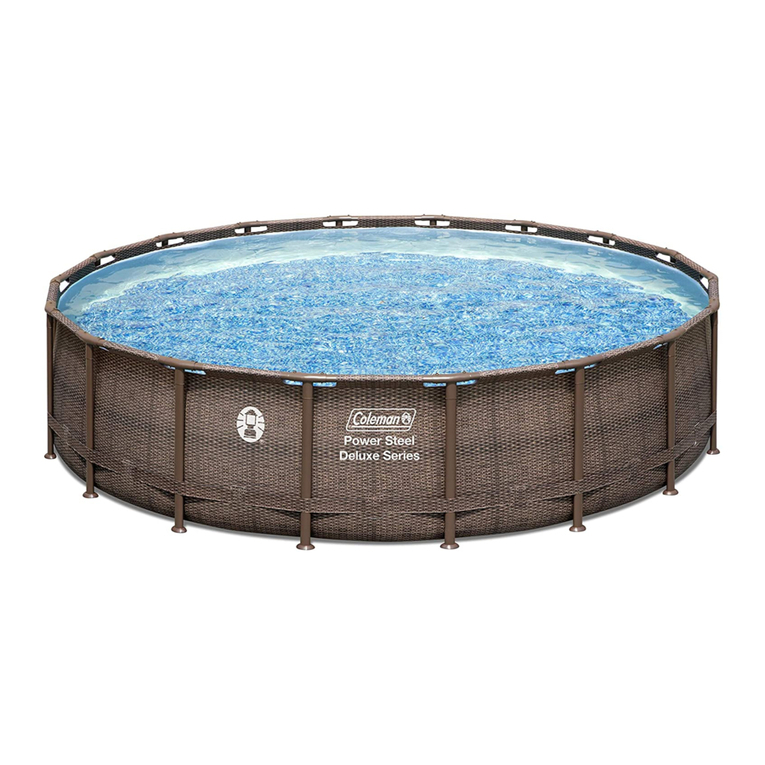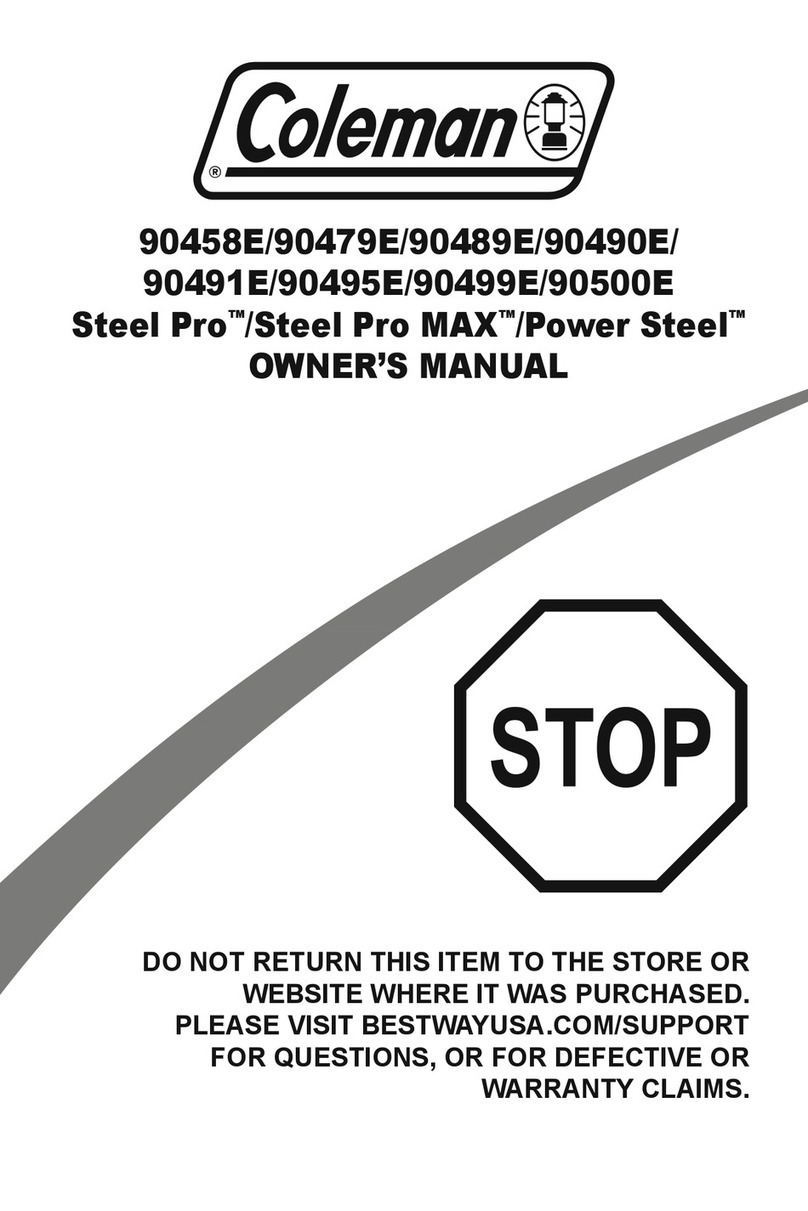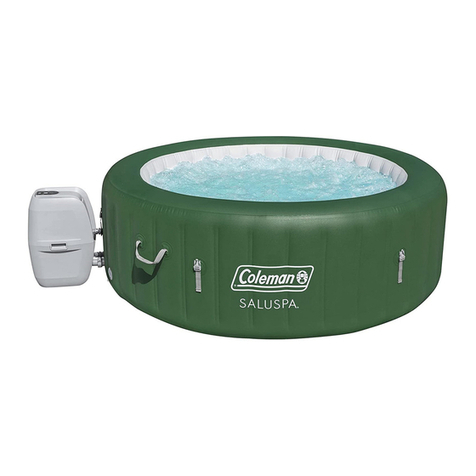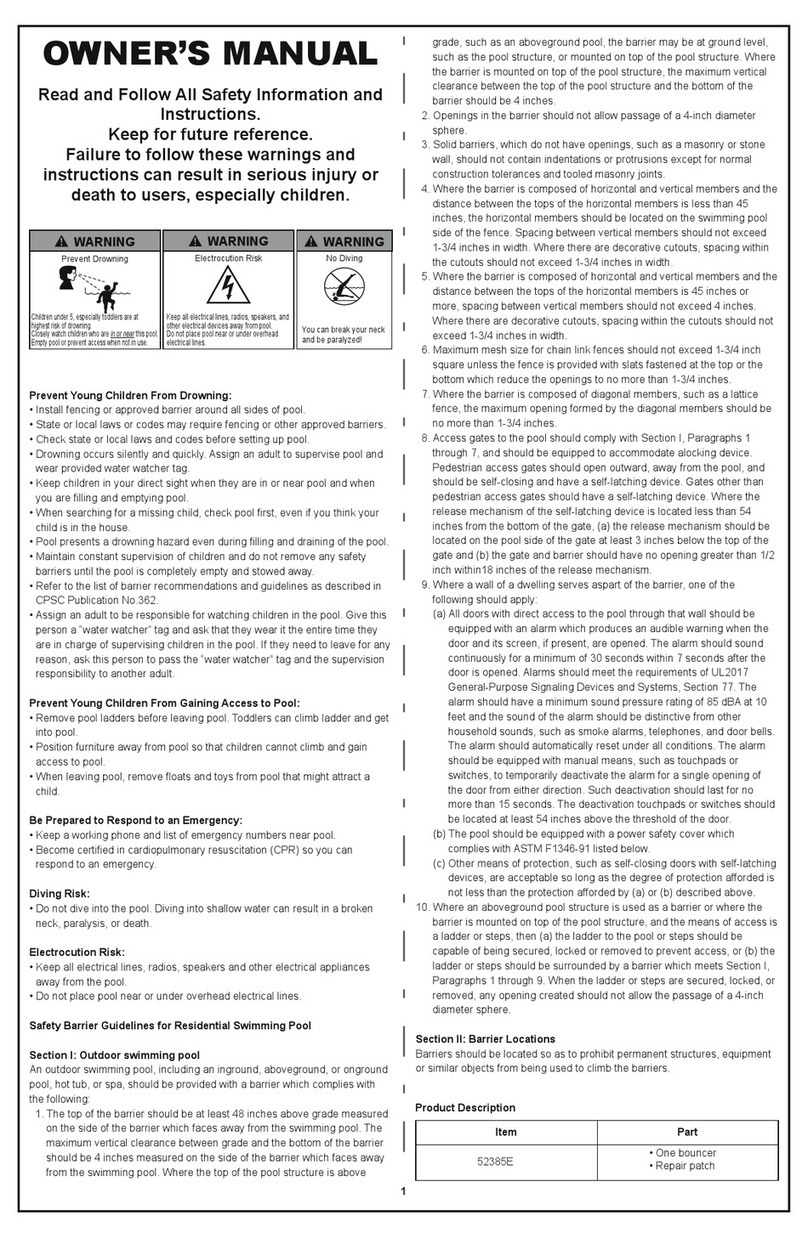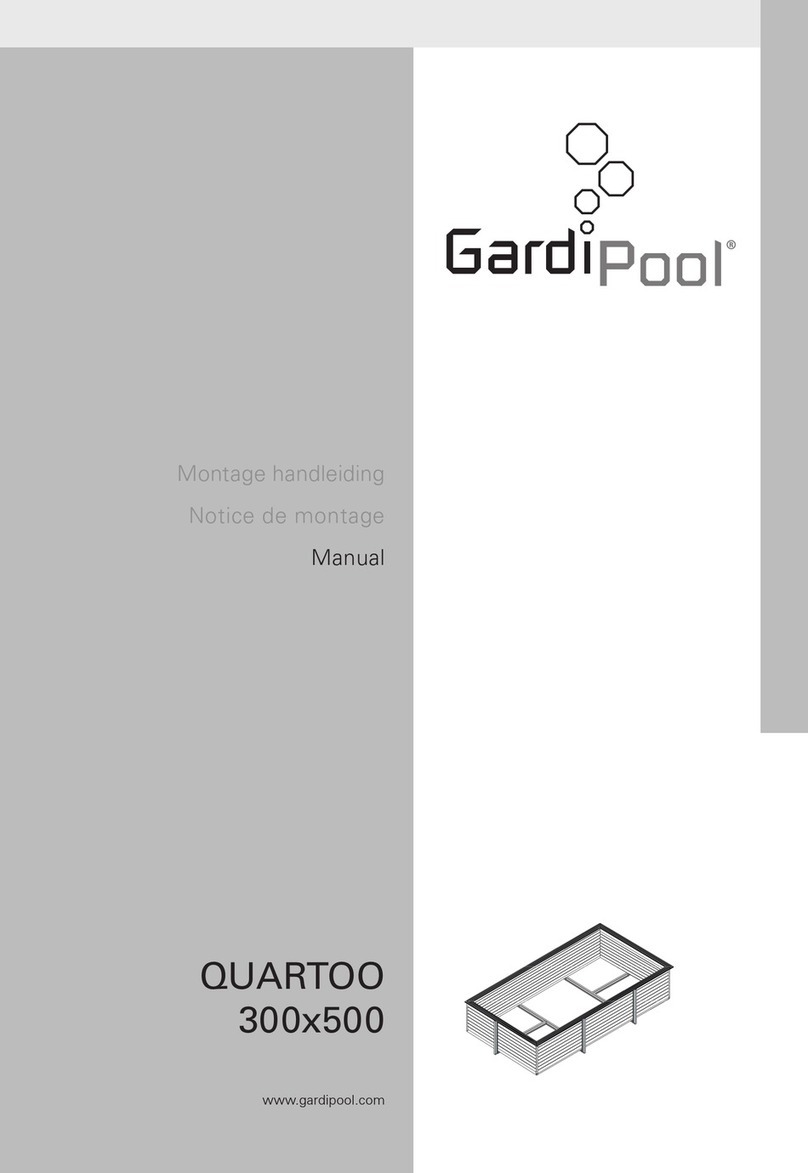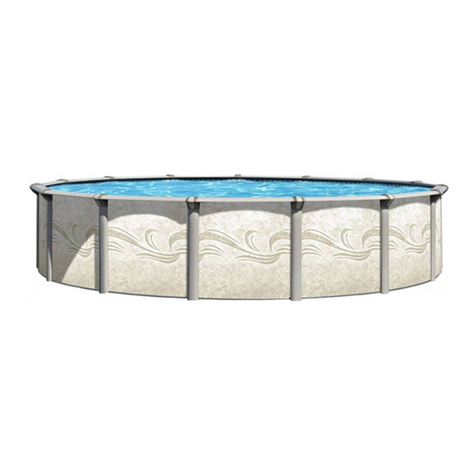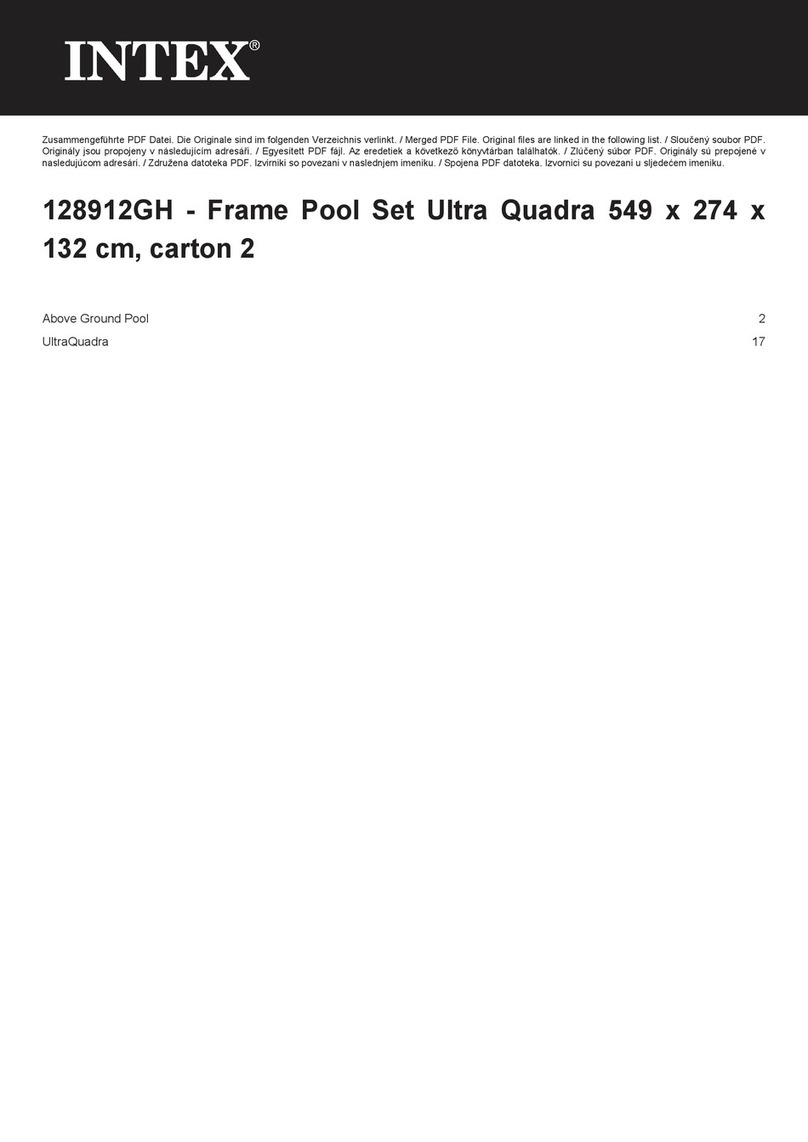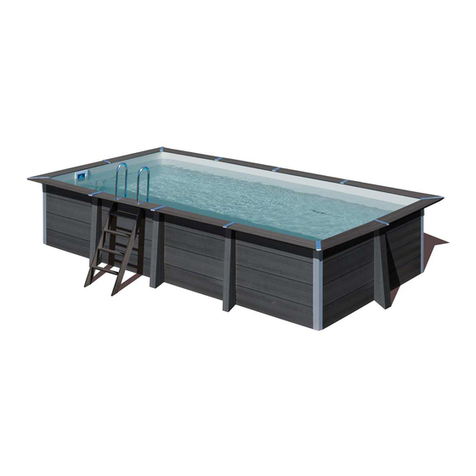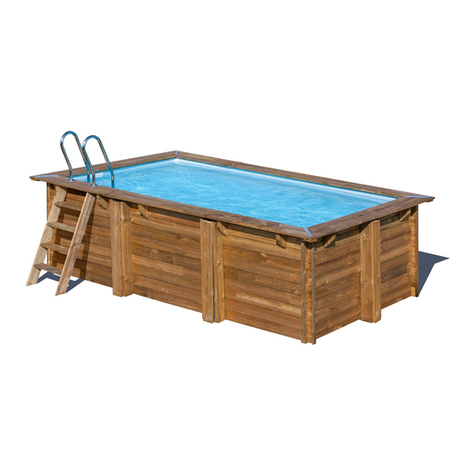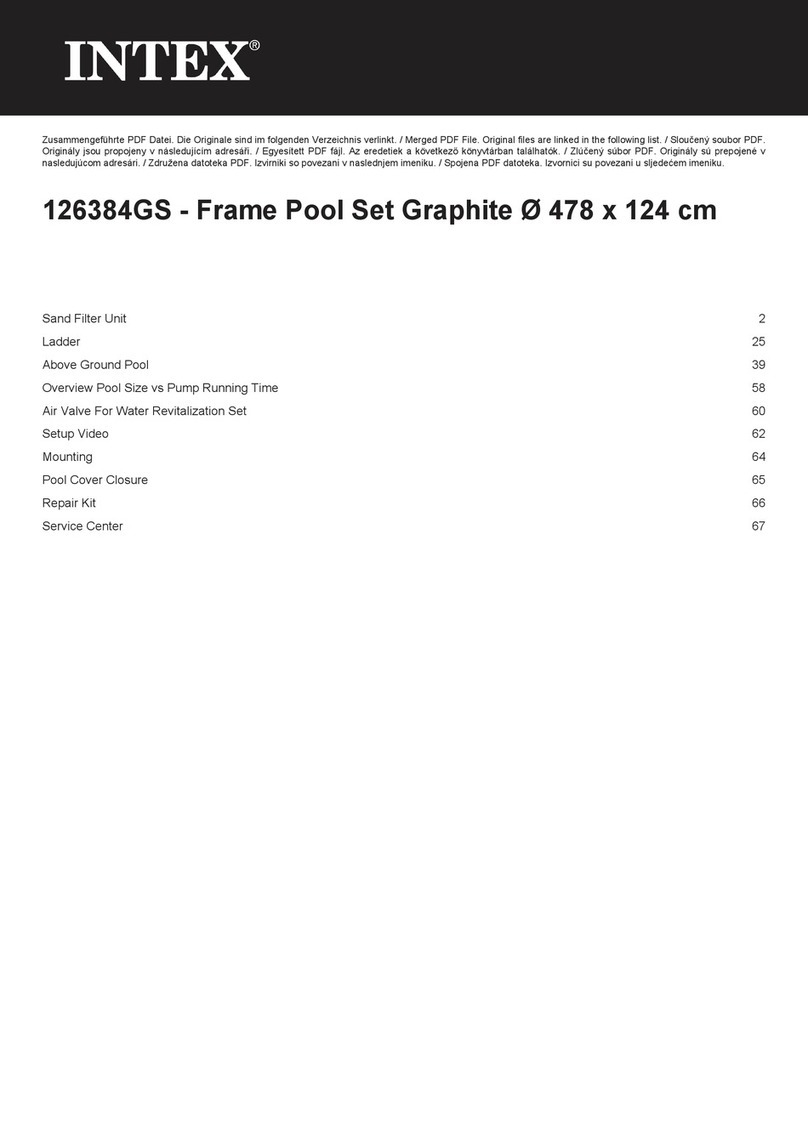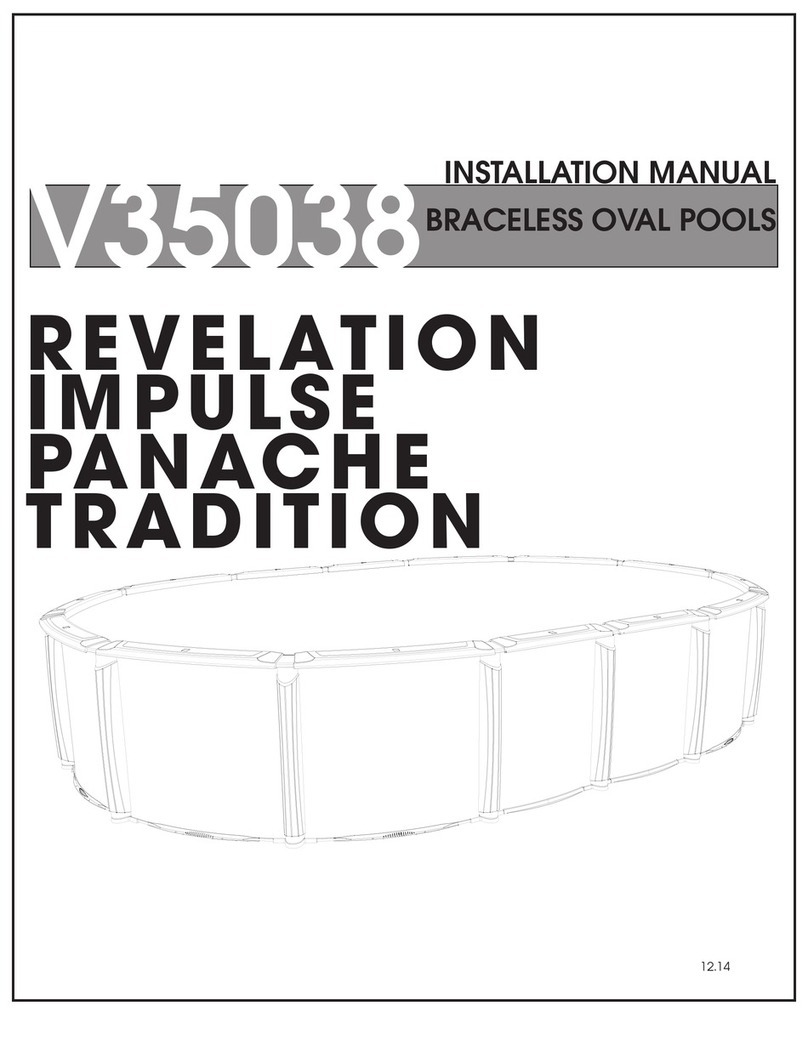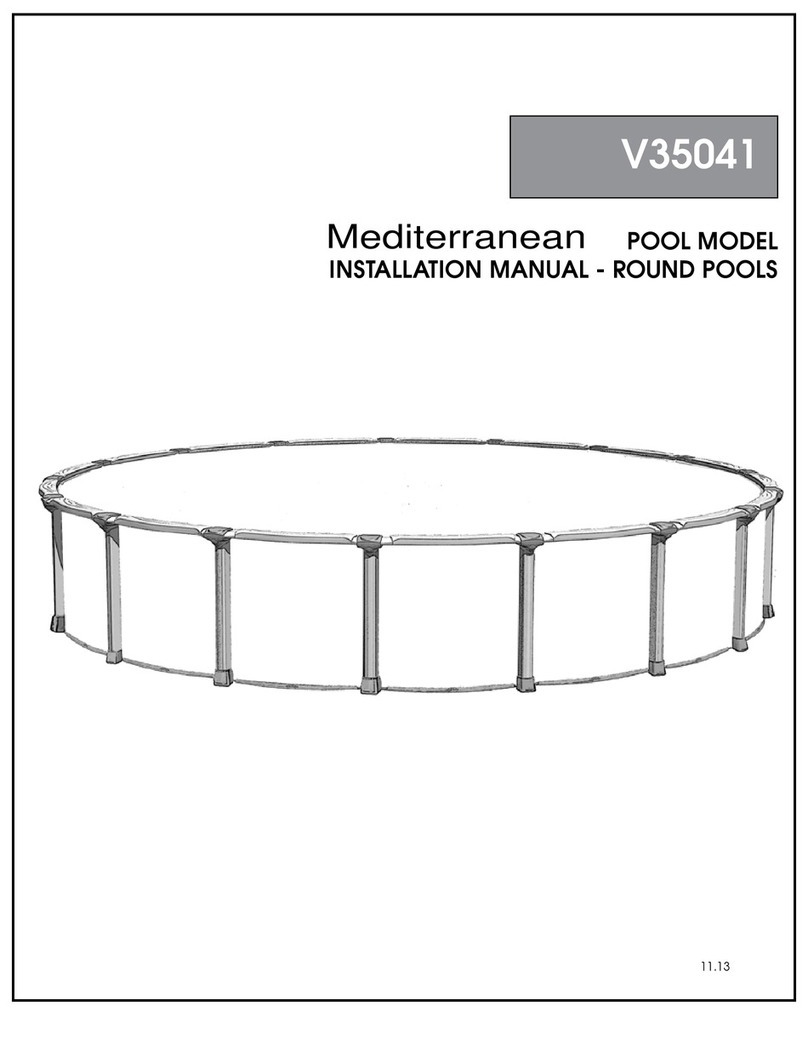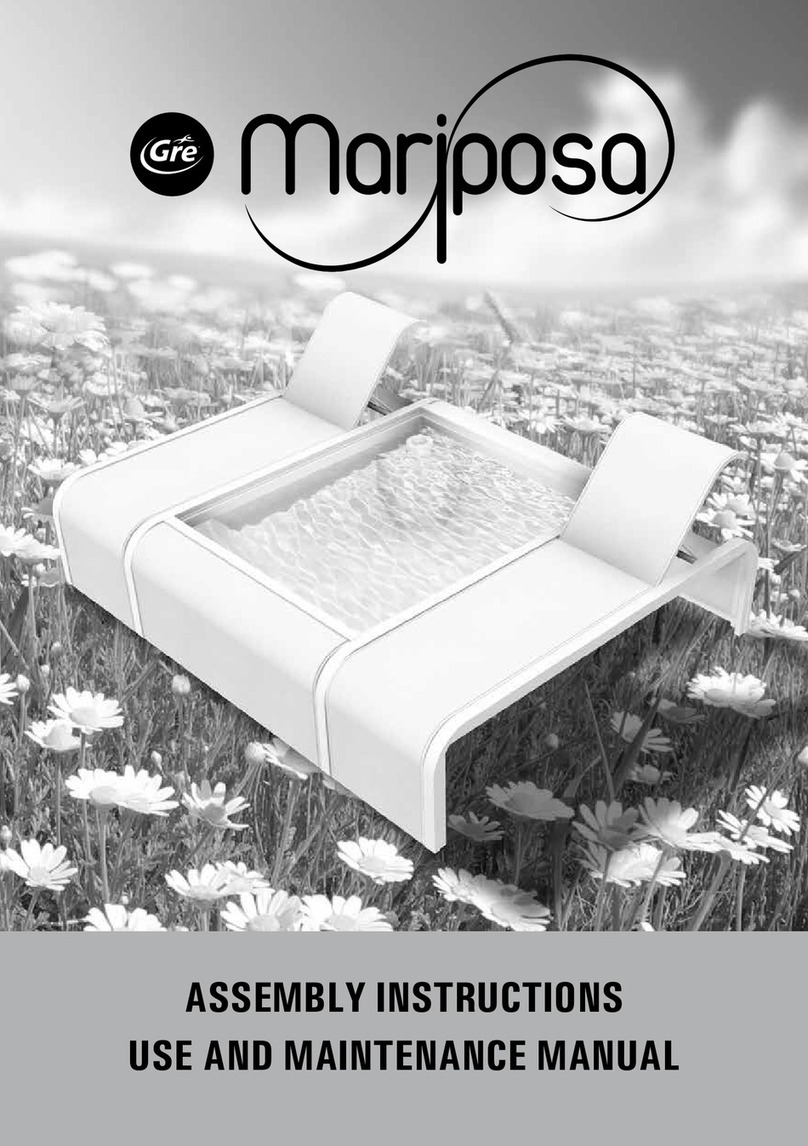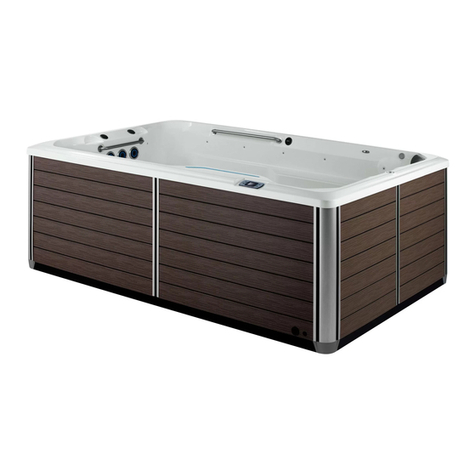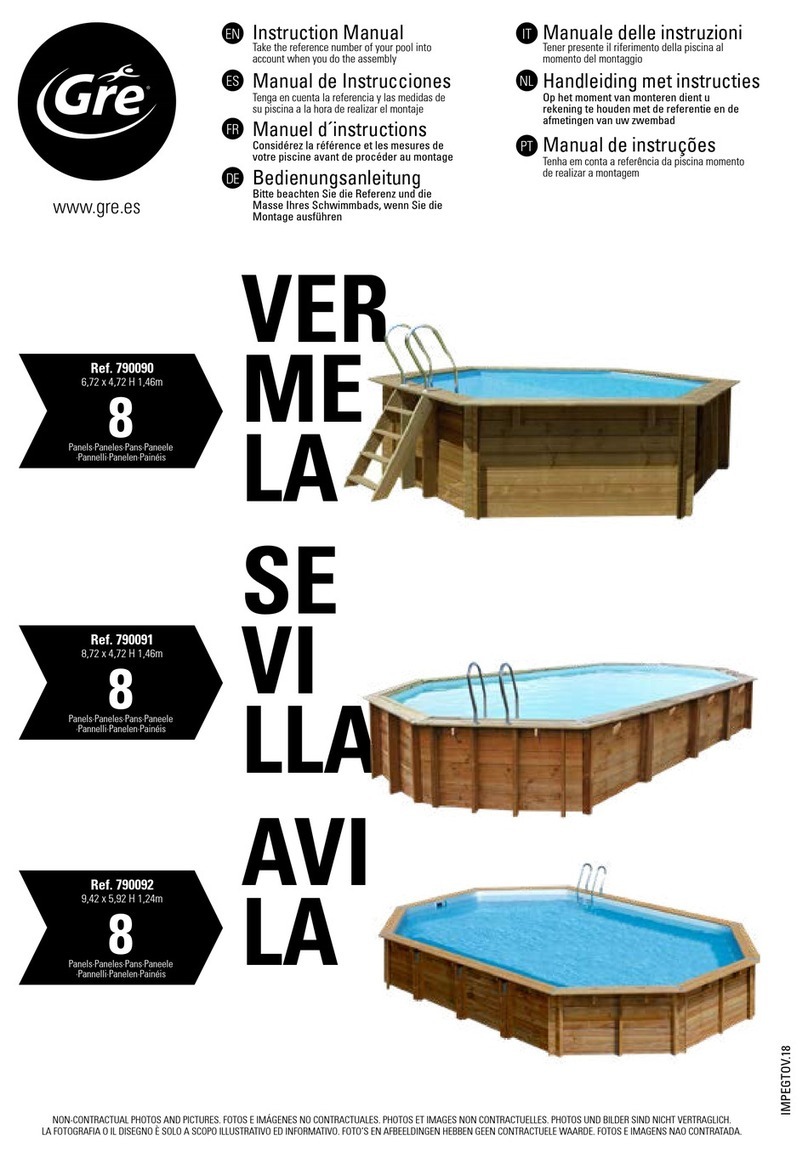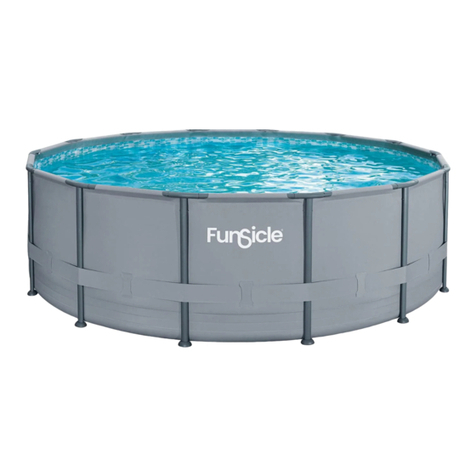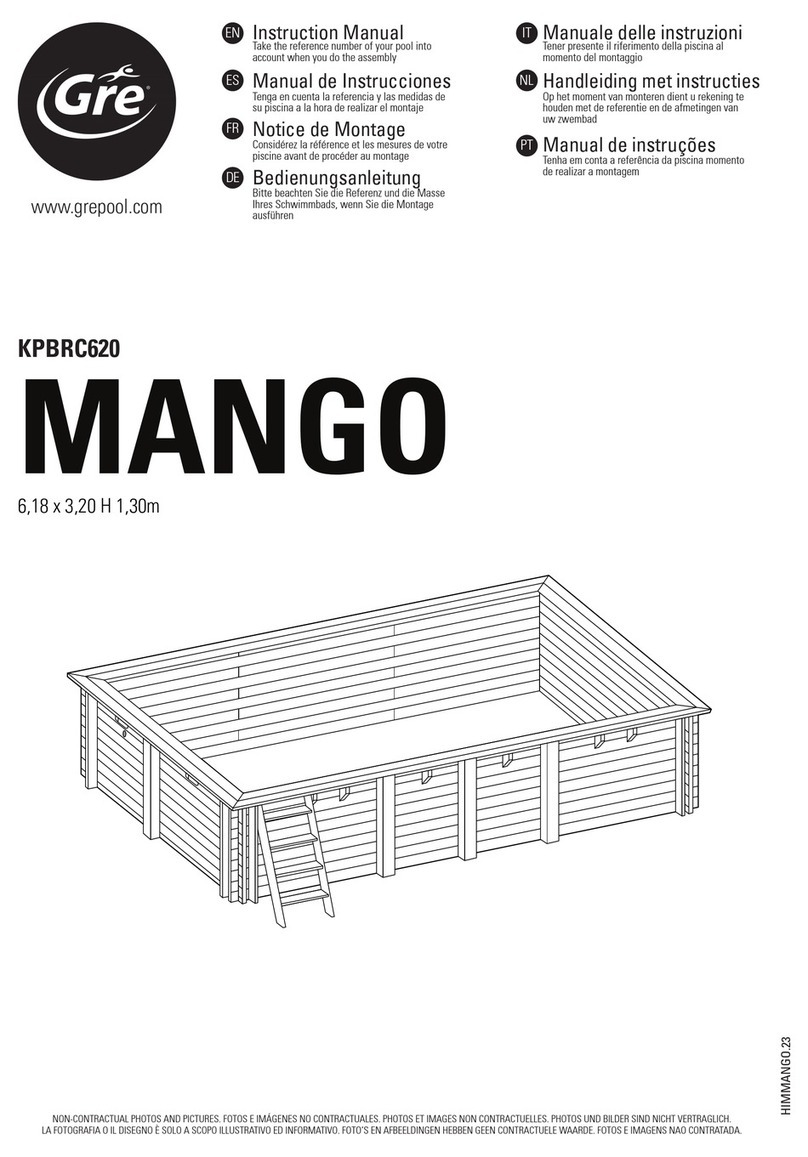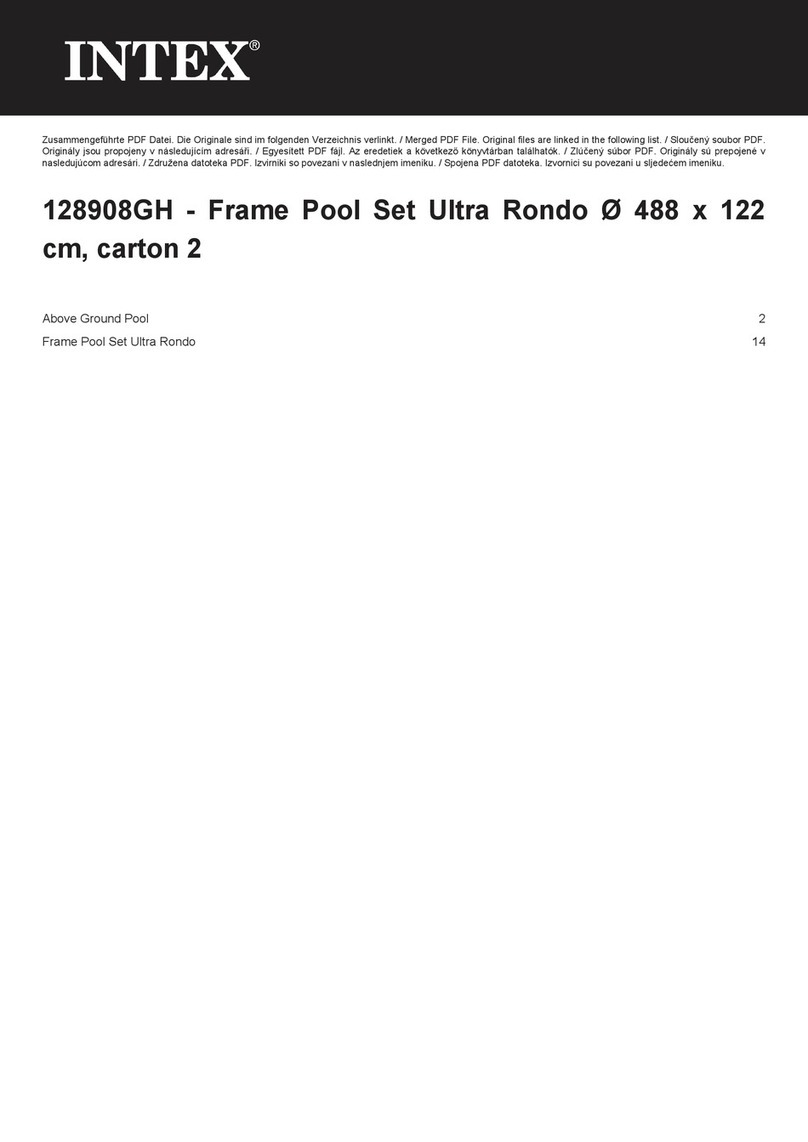
5
Only for outdoor use.
Teach your children to swim.
Never dive, jump, or slide into the pool.
Adult supervision is always required.
Parents should learn CPR.
Never swim alone.
Keep all electrical radios, speakers and other appliances away from
the swimming pool.
When you touch the filter, pump, or electrical parts, be sure the ground
under your feet is “Bone Dry.”
All electrical outlets should have a GFCI and connections should be a
minimum of 5 feet (1.52 m) from the outside perimeter of the wall of the
pool. From 5–10 feet (1.52–3.05 m), there should be either a fixed
connection (outlet box) or twist lock connection with a GFCI.
Connect power cords to a 3-wire grounding-type outlet only.
Keep all breakable objects out of the pool area.
Alcohol consumption and pool activities do not mix. Never allow
anyone to swim, dive or slide under the influence of alcohol or drugs.
Severe electrical shock could result if you install your pump or filter on
a deck. The pump or filter could fall into the water, causing severe
shock or electrocution. Do not install on a deck or other surface at,
above, or slightly below the top rail of the pool.
Do not use the pool during severe weather conditions, i.e. electrical
storms, tornadoes, etc.
Be aware of overhead power lines when vacuuming your pool or using a
telescoping pole.
Do not allow diving, climbing, sitting, or standing on the top rails of the
pools.
Do not allow roughhousing and horseplay.
Do not engage in extended breath holding activities underwater; you
may black out and drown.
Install a pool ladder(s) or staircase for entry and exit from the pool.
Keep deck clean and clear of objects that may create a tripping
hazard.
Check regularly for signs of wear or loose bolts that could make the
deck unsafe.
Instruct pool users about the proper use of all pool ladder(s) and
staircases.
Face ladder going up or down.
Allow only one person at a time on the ladder.
Check all nuts and bolts regularly to ensure that the ladder stays
sturdy.
Remove or secure the ladder to prevent entry to pool when not in use.
Please contact pool site dealer or manufacturer for additional safety
signs if deemed necessary.
For pool service, select a certified pool professional.
Any equipment connected to the circulation systems shall be
positioned so as to prevent their being used as a means of access to
the pool by young children.
The installation must comply with the codes of the authority having
jurisdiction and may require permits for building, plumbing electrical,
zoning, etc.
The pool shall be located a minimum distance of 6 ft. (1.83 m) from
any electrical receptacle.
All 125 volt, 15 and 20 ampere receptacles located within 20 ft. (6.0 m)
of the pool shall be protected by a ground fault circuit interrupter
(GFCI). The 20 ft. (6 m) distance is measured via the shortest straight
line distance the supply cord would follow without piercing a floor, wall,
ceiling, doorway, window, or other permanent barrier.
Prior to use of the pool, the installer shall affix all no diving signs and
safety signs in accordance with installation instructions so they can be
easily visible.
A barrier is necessary to provide protection against potential drowning
and near
drowning. Barriers are not a substitute for the constant
supervision of children.
A list of emergency telephone numbers shall be posted, such as the
nearest available police, fire, ambulance, and/or rescue unit. These
numbers are to be kept near the telephone that is closest to the pool.
Toys, chairs, tables, or similar objects that a young child could climb
shall be at least 4 feet (1219 mm) from the pool.
If deck is used by the installer, it will need to comply with APSP-8.
Basic lifesaving equipment, including one of the following, shall be on
hand at all times: a. A light, strong, rigid pole (shepherd’s crook) not
less than 12 ft. (3.66 m) long. b. A minimum ¼ in. (6 mm) diameter
rope as long as 1½ times the maximum width of the pool or 50 feet
(15.24 m), whichever is less, which has been firmly attached to a
Coast Guard-approved ring buoy, or similarly approved flotation
devices.
The swimming pool cover is not designated as a safety barrier.
Please use artificial lighting during nighttime pool use, to illuminate all
safety signs, ladders, steps, deck surfaces and walks.
The pool is subject to wear and deterioration. If not maintained
properly, certain types of excessive or accelerated deterioration can
lead to failure of the pool structure that
might release large quantities of
water that could cause bodily harm and property damage.
The bottom of the pool shall be visible at all times from the outside
perimeter of the pool.
The installer of the vinyl liner shall affix on the original or replacement
liner, or on the pool structure, all safety signs in accordance with the
manufacturer’s instructions.
If you have a filter pump, refer to the pump’s manual for instructions.
The ladder shall be located on a solid base and the ladder shall be
installed per the ladder’s instructions.
Publications are available that describe the risk of drowning,
entrapment, and diving accidents. Available publications related to pool
safety include the Association of Pool and Spa Professionals’ (APSP)
booklets entitled: The Sensible Way to Enjoy Your
Aboveground/Onground Swimming Pool, Children Aren’t Waterproof,
Pool and Spa Emergency Procedures for Infants and Children, Layers
of Protection, and the latest published edition of ANSI/APSP-8 Model
Barrier Code for Residential Swimming Pools, Spas, and Hot Tubs.
For additional safety information, see www.APSP.org.
THIS PRODUCT IS COMPLIANT TO ANSI/ APSP 4 AMERICAN
NATIONAL STANDARD FOR ABOVEGROUND POOLS /
ONGROUND RESIDENTIAL SWIMMING POOLS & INTERNATIONAL
SWIMMING POOL & SPA CODE (ISPSC)
(Only for USA & only for pools with a water depth of more than
36in.(914mm)
NOTE: If your purchased pool set do not have any circulation
system, you can purchase separately. But please make sure the
equipment can turn over total volume of pool water no less than once
every 12 hr. You can check the water capacity on packaging to select
suitable circulation system. Pump provided for the circulation of water
shall be tested by a Nationally Recognized Testing Laboratory and
certified to conform to UL1081.
Also make sure the selected suction outlet sold with the pump should
be tested by a Nationally Recognized Testing Laboratory and certified
to conform to ASME/ANSI A112.19.8 or its successor standard ANSI/
APSP-16, in order to prevent suction entrapment.
Please read carefully and keep for future
reference.
CHOOSE THE CORRECT LOCATION
The surface chosen to install the pool must respect the following
technical characteristics:
1. Because of the combined weight of the water inside the pool and the
pool users, it is extremely important that the surface chosen to install
the pool is capable of uniformly supporting the total weight for the
entire time the pool is installed. When choosing the surface, take
into consideration that water may come out of the pool when in use
or in the rain. If the water softens the surface, it may lose its
capability to support the pool weight.
2. Check regularly the position of the vertical legs and the U-supports.
They must be on the same level as the bottom of the pool at all
times. If the vertical leg or the U-support starts to sink into the
ground, drain the water immediately to avoid the pool collapsing due
to the uneven loading on the frame structure. Change the location of
the pool or modify the surface material.
3. We recommend positioning the pool away from any objects children
could use to climb into the pool.
4. Position the pool near an adequate drainage system to deal with
overflow or to discharge the pool.
5. The surface must be flat and smooth. If the surface is inclined or
uneven, it can create an unbalanced loading on the structure of the
pool. This situation can damage the welding point of the liner and
bend the frame. In the worst cases, the pool can collapse, causing
serious personal injury and/or damage to personal property.
6. The selected surface must be clear of any type of object. Due to the
weight of the water, any object under the pool could damage or
perforate the bottom of the pool.
7. The selected surface must be clear of aggressive plants and weed
species. Those types of strong vegetation could grow through the
liner and create water leakage. The grass or other vegetation that
may cause odor or slime to develop have to be eliminated from the
set-up location.
8. The selected location must not have overhead power lines or trees.
Be sure the location does not contain underground utility pipes, lines
or cables of any kind.
9. The selected position must be far from house entrance. Do not
position any equipment or other furniture around the pool. The water
that comes out of the pool during the use or due to a faulty product
can damage the furniture inside the house or surrounding the pool.
10. The selected surface must be flat and without holes that can
damage the material of the liner. Follow the important instructions
above to choose the correct surface and location to set up your pool.
Damaged parts of the pool, due to the fact that the set-up surface
and location does not match the instructions, will not be considered
as manufacture defect and will avoid the warranty and any service
claims.
Suggested set-up surfaces: grass, ground, concrete, and all other
surfaces that respect the above set-up conditions.
Not suggested surfaces: mud, sand, gravel, deck, balcony, driveway,
platform, soft/loose soil or other surface that does not meet the above
set-up conditions.
NOTE: Check with your local city council for by-laws relating to
fencing, barriers, lighting and safety requirements and ensure you
comply with all laws.
NOTE: If have a filter pump, refer to the pump’s manual for
instructions.
NOTE: The ladder must match the pool size and should be used
only for entering and exiting the pool. It is forbidden to exceed the
permitted payload of the ladder. Check regularly if the ladder is
properly assembled.
COMPONENTS LIST
NOTE: Some parts already have been installed on
the pool.
STRUCTURE
Before assembling your pool, please take a few minutes to check all the
parts and become familiar with their position.
NOTE: Drawing for illustration purpose only. May not reflect
actual product. Not to scale.
INSTALLATION
Installation usually takes approximately 20-30 minutes with 2-3 people
excluding earthworks and filling.
Assembly of the Frame Pool can be completed without tools.
To lengthen the life of your pool, it is important to sprinkle the top rail
with the Talcum Powder before assembly. Talcum Powder is not
included and easily available in the market.
Bestway will not be responsible for damage caused to the pool due to
mishandling or failure to follow these instructions.
1. Lay out all parts and check that you have the correct quantities as
listed in the components list. For assistance or FAQs, please visit
the support section on our website, www.bestwaycorp.com.
A B C
D E F
G H I
J L
N OM
K
P
16 ft. x 10 ft. x 48 in.
(4.88 m x 3.05 m x 1.22 m)
256002001510
POWER
STEEL™
A
B
C
D
E
F
G
H
I
J
K
L
M
N
O
P
x2
x0
x8
x4
x6
x4
x0
x10
x10
x4
x1
x1
x1
x3
x0
x0
26 ft. x 12 ft. x 52 in.
(7.92 m x 3.66 m x 1.32 m)
256002001511
x2
x8
x8
x0
x6
x4
x0
x10
x10
x10
x1
x1
x1
x2
x1
x1
NOTE:
The installation drawing for the Top Rail and the
T-Connector of 16 ft. x 10 ft. x 48 in. (4.88 m x 3.05 m x 1.22 m).
NOTE:
The installation drawing for the Top Rail and the
T-Connector of 26 ft. x 12 ft. x 52 in. (7.92 m x 3.66 m x 1.32 m).
F
F
F
F
CCCC
C
C
C
C
EEE
E
E
E
A
D
D
A
D
D
B
F
F
F
F
CCCC
C
C
C
C
EEE
E
E
E
A
BBB
B
A
BBB


